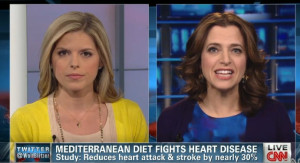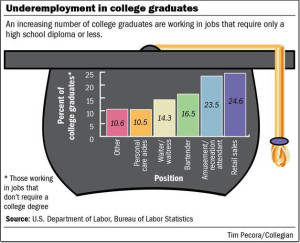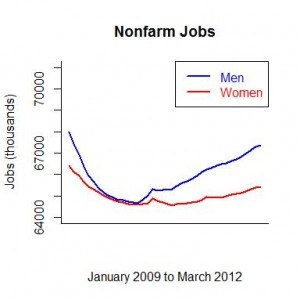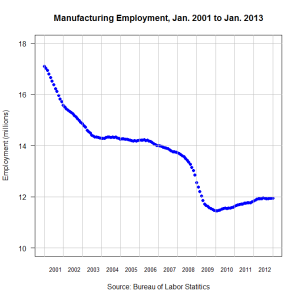Subscribe to Blog via Email
Good Stats Bad Stats
Search Text
April 2025 S M T W T F S 1 2 3 4 5 6 7 8 9 10 11 12 13 14 15 16 17 18 19 20 21 22 23 24 25 26 27 28 29 30 -
Recent Posts
Good Stats Bad Stats
goodstatsbadstats.com
Health and eating well – the Mediterranean Diet
 Last week there was much reporting on the benefits of he Mediterranean Diet based on a paper in the New England Journal of Medicine. CNN described it as “particularly large and well done study.” They went on to say that the Mediterranean Diet could reduce the incidence of heart attack and stroke by nearly 30%.
Last week there was much reporting on the benefits of he Mediterranean Diet based on a paper in the New England Journal of Medicine. CNN described it as “particularly large and well done study.” They went on to say that the Mediterranean Diet could reduce the incidence of heart attack and stroke by nearly 30%.
That sounds great.
But what did the study actually show? A copy of the paper is readily available online. The abstract for the paper claims:
We designed a randomized trial to test the efficacy of two Mediterranean diets (one supplemented with extra-virgin olive oil and another with nuts), as compared with a control diet (advice on a low-fat diet), on primary cardiovascular prevention.
The paper concludes with the claim:
The results support the benefits of the Mediterranean diet for the primary prevention of cardiovascular disease.
Is it any wonder that the media is out telling us all the benefits of the Mediterranean Diet?
But it turns out that is not quite what the paper actually says. The people studied were a bit older and not as healthy as many. The authors are very much up front with that. The study include woman ages 60 to 80 and men ages 55 to 80 who:
had either type 2 diabetes mellitus or at least three of the following major risk factors: smoking, hypertension, elevated low-density lipoprotein cholesterol levels, low high-density lipoprotein cholesterol levels, overweight or obesity, or a family history of premature coronary heart disease.
In other word they were not the young and healthy. They were not at all representative of the general population.
A key tenet of data analysis is to be vary careful applying the results of any study beyond the class of subjects in the study. Any claims of the universal benefits of the Mediterranean diet to the general public is not justified based on this study. The authors have looked only at an older segment of the population with known health risks. So if you have many of the well known risks of heart disease it may well be worth following the diet. If you don’t have those risks the study is not very informative.
Another point to consider is what the diet was compared to. The control group for the study was given some basic instruction on healthful diets. But in general the study compares those following the Mediterranean Diet to the diet of the general population. There are any number of “healthy diets.” Heart specialists for years have been saying reduce consumption of red meats and eat plenty of fruits and vegetables. These are all components of the Mediterranean diet. So perhaps the study is just one more in the long list of those that say eat well if you want to remain healthy. But even that is giving it too much credit. A better statement would be: if you have well know risks for heart disease and stroke then eat well.
How good is the claimed 30% reduction in the risk of heart attack and strokes? We are used to hearing the results of the political polls with estimates of 52% plus or minus 2%. In this “particularly large study” the authors claim something like an improvement of 30% plus or minus about 25% for the type of people they looked at. That is a difference, but covers a very large range. With that range better to just claim an improvement without highlighting the 30% estimate.
And for those who like to think that one study tells us a lot, even if the results seem significant, I must recommend the video clip of a talk given by Rebecca Goldin of George Mason University in September 2012 posted on youtube. Start at about the 48 minute mark.
Posted in The Media
College grads – How does one define underemployed?
 The graphic to the right caught my attention at the Penn State Collegian website a couple of weeks back. The article was titled “Report: Half of college graduates overqualified for current job.” That kind of title is sure to gather the attention of the students on any major college campus.
The graphic to the right caught my attention at the Penn State Collegian website a couple of weeks back. The article was titled “Report: Half of college graduates overqualified for current job.” That kind of title is sure to gather the attention of the students on any major college campus.
The data is credited to the Bureau of Labor Statistics in the graphic. However the source is a report by the Center for College Affordability and Productivity and are provided in their recent report “Why Are Recent College Graduates Underemployed? University Enrollments and Labor-Market Realities.”
The thrust of that report is that a large number of college graduates are working at jobs that do not require the education that they have so diligently worked to attain. And in the view of the Center for College Affordability and Productivity spent too much money to get.
In reality the numbers in the report are derived by the Center for College Affordability and Productivity based on Bureau of Labor Statistics (BLS) data and the centers definition of underemployment. The BLS does defines underemployment very different manner. Thus it is inappropriate to attribute the measures of underemployment in the Center for College Affordability and Productivity report to the BLS.
A rule in statistical analysis is that when claims are made that seem a bit extreme one should look very carefully at how the concepts are defined and measured. A favored tactic is to define the concept in a way than makes the number advantages to the cause being advocated. In this case consideration of how “underemployed” is derived from the BLS data is key to understanding the claims made in the center’s report.
The center used information from BLS to determine if a degree was required for a specific occupation. The authors used what BLS states as the entry level educational requirements for the occupation. For registered nurses this is an Associates Degree. This is a very conservative approach as then by the centers methodology any registered nurse who enters the field with a BS degree or later attains a BS degree is considered underemployed. This reflects a stagnant view of the labor force which says that employers do not value additional learning or training once someone a been hired. It also ignores the fact that while employers may well hire someone with a associates degree they would prefer the more advance degree. In the nursing profession BS degrees have given for well over 40 years. In the state of California over 60 percent of the 309,000 registered nurses have a BS or higher degree (American Community Survey Data, US Census Bureau, 2011 public use file calculation.) Be clear, the authors of the report are claiming that those 202,000 nurses are underemployed. It is this type of definition that results in their large estimates of underemployed in this country. They then use these inflated numbers to make their case on the value or lack there of a college education.
The Center for College Affordability and Productivity world view is very different than that most of the rest of the country. Teachers in our high schools systems usually must have a college degree. To enter the field in many jurisdictions it is not necessary to have a teaching certificate. However to be retained by the school district the individual must earn the teaching certificate within some period of time. Once having done that they are then required to take continuing education courses. Under the model of used by the center, the teaching certificate is not required to enter the profession, thus the teachers who have obtained one are now underemployed. If they go on to earn a master degree later, that are also underemployed. This same logic can be applied to just about any profession. I do not think that this is a world view that we wish to embrace. It ignores the continuing education environment that now exist in the working world.
It is upon this foundation of sand that the center built their house of straw.
There are other problems with the report. The most obvious is using data in the midst of the recession to measure their concept. A student who graduates with a 3.5 GPA, but cannot find a job in his field, not because of his or her lack of skill or training, but due to the recession who then takes a temporary job until he can find one in his profession is by the centers measures underemployed. They have placed the blame on the education variable when the blame is more properly placed on the recession. The student who goes onto graduate school but takes a part time job as a local bartender to pay for her education is considered underemployed. Every job I held while I worked my way through college years ago did not require a high school diploma. Was I underemployed. No, I was making money to pay for that college education.
A model that describes underemployment as the center has measured the term is fatally flawed. Such a concept must take into consideration the dynamics of the labor market and the dynamics of the employment situation. There are multiple ways to enter any profession. Taking the lowest common denominator and claiming that all others are underemployed is not a good measure. Taking the entry level requirements and applying that to all employees at any time in their career is not a good measure.
The State of the Union – Checking the Fact Checker
The annual State of the Union speech by the president can always be trusted to include a few numbers that can be called into question. This years speech was no different. The next morning the Washington Post fact checker was out with his take on the numbers. The interesting thing was the title of the piece “Even when you’re the commander in chief, context is everything.” Unfortunately the fact checker, Glenn Kessler in this case, forgot to pay attention to the context in his criticisms. (Just for clarity the title of the piece was for the print edition of the paper. For some reason the Post decided to use a different title for the online edition.) The White House has posted the entire text of the speech.
The first itme was the statement early in the speech:
After years of grueling recession, our businesses have created over six million new jobs
 I’m not sure why someone wants to challenge the numbers here. They are factually correct. Kessler’s complaint was that the president was guilty of “cherry-picking” the numbers. Kessler’s numbers are also correct. The numbers that the president is using date from the bottom of the recession. Kessler seems to feel that it is better to use the numbers at the beginning of the presidents first term. Back in April of last year I posted the plot to the right showing the number of jobs since January 2009. Clearly context is important here. The president said “after the grueling recession,” so his view is an accurate one. Kessler’s view it take the number starting a year earlier. But using Kessler’s date places the blame for the the job losses in the first year of Obama’s term on Obama. It is very difficult for any new president to influence the jobs situation in the first several months they are in office. If one looks at the jobs numbers for 2008 Obama clearly inherited an economy in free fall. This is the context that needs to be included in the discussion.
I’m not sure why someone wants to challenge the numbers here. They are factually correct. Kessler’s complaint was that the president was guilty of “cherry-picking” the numbers. Kessler’s numbers are also correct. The numbers that the president is using date from the bottom of the recession. Kessler seems to feel that it is better to use the numbers at the beginning of the presidents first term. Back in April of last year I posted the plot to the right showing the number of jobs since January 2009. Clearly context is important here. The president said “after the grueling recession,” so his view is an accurate one. Kessler’s view it take the number starting a year earlier. But using Kessler’s date places the blame for the the job losses in the first year of Obama’s term on Obama. It is very difficult for any new president to influence the jobs situation in the first several months they are in office. If one looks at the jobs numbers for 2008 Obama clearly inherited an economy in free fall. This is the context that needs to be included in the discussion.
An intersting thing happens when Kessler turns his attention next item. Obama said:
We buy more American cars than we have in five years, and less foreign oil than we have in 20.
Here I think I agree with Kessler’s facts. The reasons for the decline in the use of foreign oil likely have little to do with Obama’s accomplishments. Those declines are likely due to events that preceded him and to the effects of the recession. But my issue is again one of context and consitancy. Kessler does not want to let the president escape the blame on the jobs front due to factors that proceeded his term in office, yet he also will not let him claim credit for the decline in the use of foreign oil that is due to factors the preceded him. This is a question of consistency of treatment. If you will not let him off the hook the the jobs front, then consistency demands that you let him take credit on oil front. I would prefer to let him go on his jobs statement and not let him take credit for his claim on oil usage.
 The issue of manufacturing jobs is another item Kessler takes on. Obama said:
The issue of manufacturing jobs is another item Kessler takes on. Obama said:
After shedding jobs for more than 10 years, our manufacturers have added about 500,000 jobs over the past three. Caterpillar is bringing jobs back from Japan. Ford is bringing jobs back from Mexico. And this year, Apple will start making Macs in America again.
Kessler again accuses Obama of “cherry-picking” the numbers. Here he talks about the numbers of manufacturing jobs relative to the numbers when Obama took office. But Obama is clearly talking about the long term. He is focusing on the decline in manufacturing jobs that has taken place over the past ten years. The decline started long before the start of the last recession. The plot on the right clearly shows that Obama has an accurate description of the jobs situation. One can argue about him taking credit for the turnaround. But clearly a turnaround has occurred since the depths of the recession. Obama was taking credit for changing a long term trend, not for just what has happened in the recent recession. The criticism fails because Kessler has changed the context that was clearly intended in the speech.
On this one I think the fact checker need to do a better job. He needs to stay within the context of the economic situation over the long term, not get caught up in artificial dates, like the exact date the president was sworn into office. He also needs to better focus on consistency in his analysis.
Posted in Uncategorized